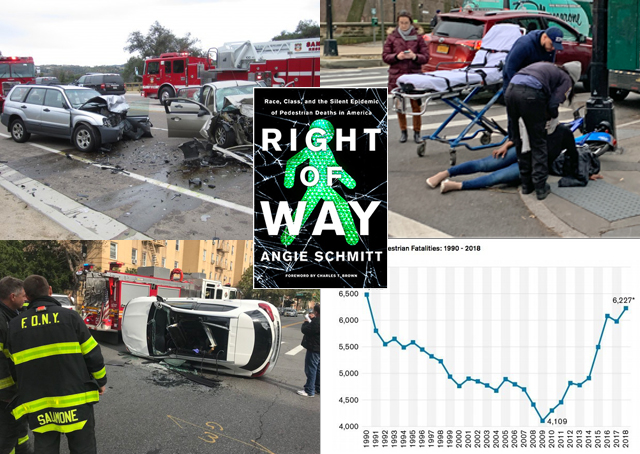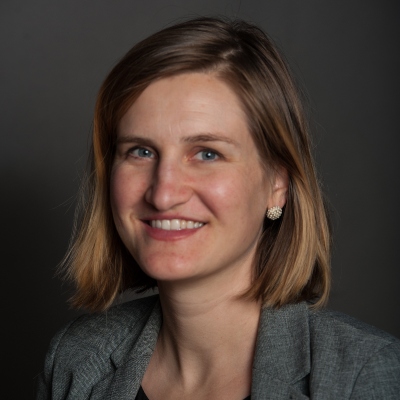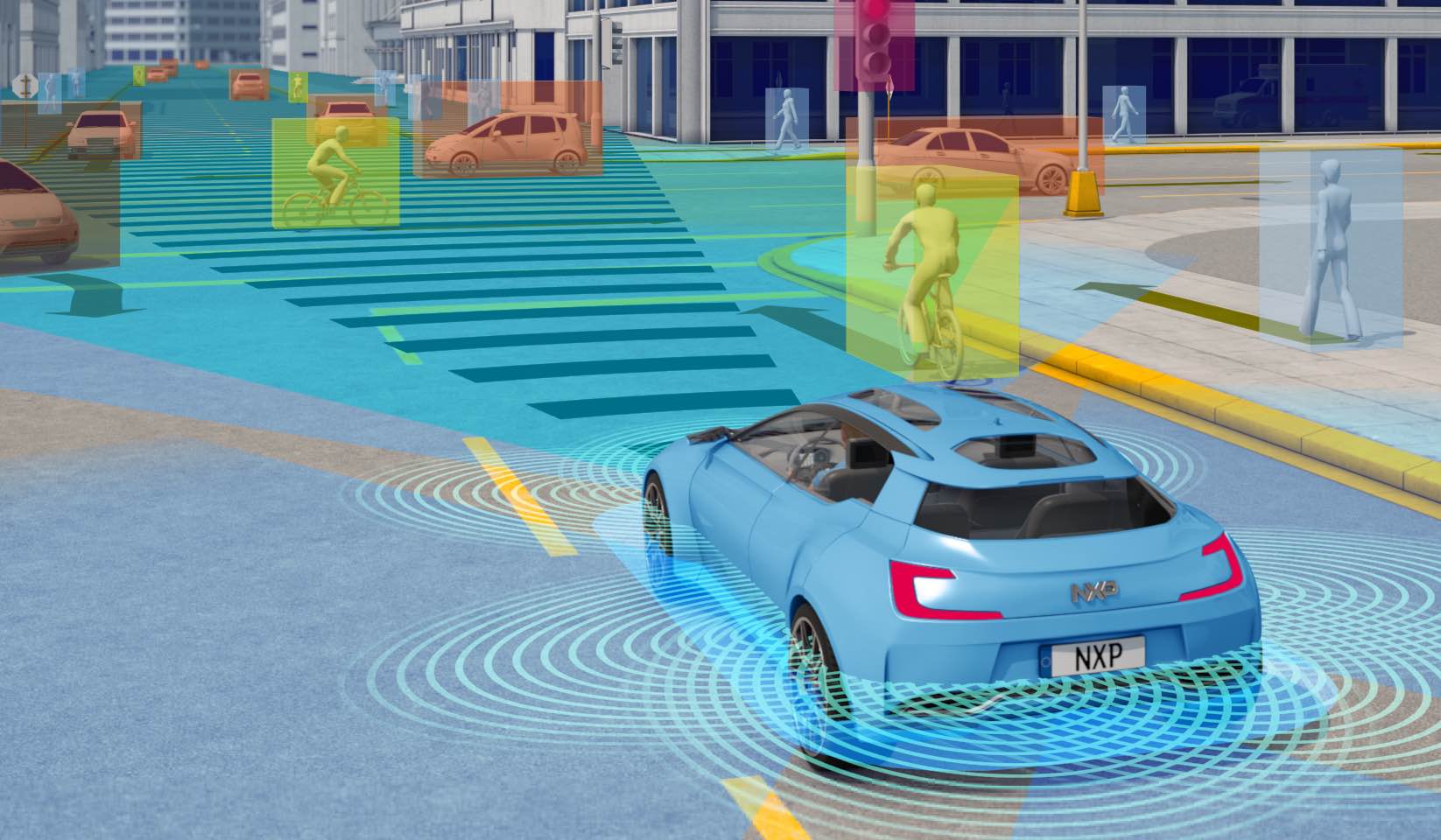Former Streetsblog USA editor and internationally recognized sustainable-transportation expert Angie Schmitt today published her pathbreaking book on the U.S. pedestrian-safety crisis, "Right of Way: Race, Class and the Silent Epidemic of Pedestrian Deaths in America" (Island Press). Schmitt recently sat for an interview, below, in which she spoke about her dawning realization of the gravity of the crisis and the safety measures that could stop it. Streetsblog featured an excerpt from the book last week.
Streetsblog: You were at the forefront of reporting on the pedestrian-safety crisis for more than a decade during your time at Streetsblog USA. What made you realize that the advocacy community needed a book like this, in addition to your years of invaluable reporting?
Angie Schmitt: So, I think we were always more focused on bikes and transit at Streetsblog, obviously. I came to this from bike commuting, like I think a lot of readers did. After I had kids though I pretty much stopped biking for a while and started doing most of my trips on foot, with strollers. You can’t even put a kid on a bike until they are nine months old (around there) so I didn’t really have much alternative. And I still don’t bike nearly as much as I used to now that my kids aren’t babies anymore.
At the same time there was this big unexplained increase in pedestrian deaths happening. And I’m embarrassed to say it took me as long as it did, but I started figuring out how changes in the car industry were contributing to the problem. I believe I was the first person to report on the connection between SUV sales and rising pedestrian deaths, but it has since been confirmed with a bunch of data.
So, anyway, long-story short, I thought it was an injustice that there wasn’t more attention to this issue. There are about 10 times as many pedestrian deaths a year as cyclists. But they don’t have the same kind of resources and support. I think that’s because a lot of people who walk in a lot of parts of the U.S. are poor, and marginalized in other ways as well — race, disability status, age, immigration status, etc.
Another realization I had after years of reporting is that people who lose loved ones to traffic deaths don’t get their stories told. So many people lose family members to traffic deaths and it is so devastating, but they don’t get sympathetic profiles in the media, like people do with other untimely deaths. So I think that is part of the reason why the issue has been sort of invisible.
Streetsblog: Even die-hard street-safety advocates who think they know it all will find some surprising and crucial insights in "Right of Way." What surprised you most as you wrote it?
AS: Going into writing this, I think my perspective was, and the sort of conventional wisdom was, pedestrians need the same things bicyclists need. That adding bike lanes to streets was the answer. But I think that comes from the fact that bicyclists have been the more visible and well-resourced advocates.
One of the things pedestrians really need is good lighting, is streetlights that function and are in the right places. Because about three quarters of pedestrians deaths occur at night.
I still like road diets and bike lanes. But I also think there’s a whole range of amenities pedestrians need and aren’t getting (enough), like pedestrian islands, retimed “Walk” signals, curb ramps, etc, that aren’t either real design-y or real “war on cars” type fights that have been overlooked.
Streetsblog: You finished writing this book shortly before the COVID-19 pandemic, and months before the national Black Lives Matter protests in the wake of the murder of George Floyd. How have those events deepened or changed the message of the book? What do you think you might add to subsequent editions, or a follow-up book on this topic, in light of this historic time?
AS: So, yeah. it was completely finished before all that happened, which is weird as an author. That’s sort of the nature of books though. One thing I would say is now we’re having to think about how to we “rebuild.” And we have to change the way we do everything — especially in light of the protests, I think.
Obviously, police and criminal-justice reform is the key thing there and there are ways it overlaps with this problem. There’s the question of enforcement and whether police can be trusted to do that (probably not right now). And then there are black and brown people (mostly young men) who are being harassed and arrested and fined for “jaywalking.”
But some of this stuff is only vaguely connected to that. I don’t want to pretend it’s something it isn’t. One of the themes in book is why are black and brown and/or native folks being killed more while walking. And it’s a little complex, but one reason is that their neighborhoods have been discriminated against. They haven’t gotten everything they need to be safe. And by the way, those neighborhoods tend to walk the most and need the safety amenities the most.
So hopefully the planning industry will come out of this transformed and there are smarter folks than me sort of leading the way on racial justice. But this is one area where I think more of a racial-justice focus and a reframing is due.
Streetsblog: You're launching a planning and consulting firm, 3 MPH. Tell us about that, and how writing "Right of Way" led you down that path.
AS: I worked for Streetsblog for so long and, working on this book, I just learned so much. And it got me thinking, I know more about this topic than almost anyone. And I thought maybe with the following I have I can sell people on doing this stuff, trying to fix some of these issues. There’s a lot of men in planning that have written books and then used it to sort of get into consulting, so I thought, if they can do it, I can, too.
Anyway, during my research I read this really good book about traffic safety, this sort of obscure book by a Canadian researcher named Neil Arason ("No Accident"). And one thing it advocates was pedestrian-safety audits, which have a 10-to-1 return on investment. So, anyway, that’s one thing I want to do.
After doing all this, I know what to look for, what the problems might be, whether it’s lighting, or the placement of the bus stops, or whatever. But, also, it’s a very localized problem. So that process, the walking audit or pedestrian safety audit, is really about involving local folks, street users in the planning process. And also it gets public officials to experience the street on foot — and that lack of experience is a big part of the political problem around this, I think.
We haven’t prioritized safety in our planning, I don’t think. The money and the effort go into solving problems like congestion, which is truly a minor problem compared to traffic deaths and injuries. Even in cities, safety hasn’t been the big focus I think. A lot of times it’s about boosting a business district or something like that. But this safety stuff would be relatively cheap to fix. So in a way I think it’s actually sort of a radical idea, what I’m trying to do, even though it probably sounds boring, because it’s about lots of small little fixes.
I think we would get way more value as a society out of that kind of approach, but it’s just been considered unsexy compared to, like, the big ribbon cutting on a flashy new project.
Streetsblog: What's one insight in "Right of Way" that you wish every American would know? Or what's one insight you wish every American presidential hopeful would know?
AS: I think this issue has just not even been considered at all, right? Nobody sees this as a problem in the first place. So, that’s one thing I was hoping to address with the book. We should look at this as a social problem that we can fix with political action. Like we have had a political awakening about gun deaths.
Even, since you bring up presidential candidates, Joe Biden. It was interesting watching the DNC. Joe Biden lost two family members in a car wreck, right? Devastating experience, huge part of his life story. And, anyway, in the DNC there’s a big thing about how he’s trying to end cancer because his son Beau died of cancer, as well. And I guess ending cancer is non-controversial, but Joe Biden, with all his experience, probably doesn’t see those car deaths as political — even though he has the insight to see cancer that way.
Those weren’t pedestrian deaths, but there’s the same sort of lack of consciousness about car wrecks in general. We don’t have to just accept them, and they aren’t just acts of God. They are very often the result of political decisions about what our values are (speed vs. safety) or, in the case of pedestrians in particular, whose lives matter.







